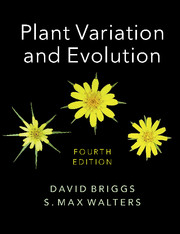Book contents
- Frontmatter
- Contents
- Preface to the Fourth Edition
- Acknowledgements
- Note on names of plants
- List of abbreviations
- 1 Investigating plant variation and evolution
- 2 From Ray to Darwin
- 3 Early work on biometry
- 4 Early work on the basis of individual variation
- 5 Post-Darwinian ideas about evolution
- 6 DNA: towards an understanding of heredity and molecular evolution
- 7 Breeding systems
- 8 Intraspecific variation and the ecotype concept
- 9 Pattern and process in plant populations
- 10 Pattern and process: factors interacting with natural selection
- 11 Populations: origins and extinctions
- 12 Species and speciation: concepts and models
- 13 Allopatric speciation and hybridisation
- 14 Abrupt speciation
- 15 The species concept
- 16 Flowering plant evolution: advances, challenges and prospects
- 17 Historical biogeography
- 18 The evolutionary impact of human activities
- 19 The taxonomic challenge ahead
- 20 Conservation: from protection to restoration and beyond
- Glossary
- References
- Index
17 - Historical biogeography
Published online by Cambridge University Press: 05 June 2016
- Frontmatter
- Contents
- Preface to the Fourth Edition
- Acknowledgements
- Note on names of plants
- List of abbreviations
- 1 Investigating plant variation and evolution
- 2 From Ray to Darwin
- 3 Early work on biometry
- 4 Early work on the basis of individual variation
- 5 Post-Darwinian ideas about evolution
- 6 DNA: towards an understanding of heredity and molecular evolution
- 7 Breeding systems
- 8 Intraspecific variation and the ecotype concept
- 9 Pattern and process in plant populations
- 10 Pattern and process: factors interacting with natural selection
- 11 Populations: origins and extinctions
- 12 Species and speciation: concepts and models
- 13 Allopatric speciation and hybridisation
- 14 Abrupt speciation
- 15 The species concept
- 16 Flowering plant evolution: advances, challenges and prospects
- 17 Historical biogeography
- 18 The evolutionary impact of human activities
- 19 The taxonomic challenge ahead
- 20 Conservation: from protection to restoration and beyond
- Glossary
- References
- Index
Summary
One of the areas of plant evolutionary studies most enriched and stimulated by advances in molecular phylogeny is historical plant biogeography. ‘Earth history has profoundly influenced the geographic ranges of species … evolutionary histories of areas and lineages are tightly coupled’ (Ree & Smith, 2008). This long-standing botanical discipline has now been invigorated by advances in plate tectonics; the investigation of patterns and processes of dispersal (including the increasing use of analytical models); and the development of phylogeography (Avise, 2000). Phylogeography is an offshoot of the cladistic approaches devised by Hennig. One of the key advances was the realisation that phylogenetic diagrams, which have taxonomic entities at their branch tips, can be overlaid, or considered, together with geographical information, such as country of origin of each taxon, or geographical origins can be substituted for taxon names. Two classes of branching structures are then available for analysis, one with taxa and another, of the same data set, but with geographical details. Also, information on timeframes can be included. These are particularly revealing when estimates employing relaxed molecular clocks are calibrated against fossil evidence (Wikström, Savolainen & Chase, 2007; Magallón & Castillo, 2009). In addition, molecular evidence can be combined with information on the environments and ecosystems of the past.
These approaches, together with new advances in our understanding of Earth's history, have shed new light on many questions that have long intrigued botanists about the role of natural selection and chance events in dispersal, speciation, adaptive radiation, hybridisation and extinction. To appreciate the significant progress that has been made, a brief historical account of several puzzling biogeographical phenomena is helpful (see Lomolino et al., 2005). Here we concentrate on a number of key issues, as they influence plant evolution.
The Deluge and Noah's Ark
In a fascinating book, Browne (1983) reveals that, in the seventeenth century many scholars, convinced of the literal truth of the story of Noah's Ark, raised a number of questions. How did all the animals fit into the Ark? How were they fed, housed and the dung removed? In search of answers, the German Jesuit priest Kircher produced a representation of the Ark as a long rectangular box-like structure of three decks, shaped more like a modern cruise liner than the traditional pyramidal structure commonly reproduced in children's toys and in works of art.
- Type
- Chapter
- Information
- Plant Variation and Evolution , pp. 382 - 410Publisher: Cambridge University PressPrint publication year: 2016

